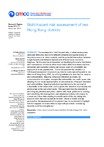The assessment of multi-hazard risks in urban areas poses particular difficulties due to the different temporal and spatial scales of hazardous events in urban contexts, and the potential interactions between single hazards and between hazards and different socio-economic fragilities. Yet this exercise is important, as identifying the spatial distribution and concentration of risks in urban areas helps determine where and how preventive and corrective actions can reduce levels of vulnerability and exposure of urban populations. This article presents the results of a GIS-based assessment of present day risks to socio-natural hazards in two districts of Hong Kong (PRC) by utilizing indicators to describe the hazards and vulnerabilities. Mapping composite indicators facilitates the communication of complex concepts like vulnerability and multi-hazard risk, allowing for the visual representation of concentrations of hazard intensities and vulnerabilities. Mapping indicators operationalizes the concept of vulnerability at the urban level, and supports the detection of potentially risk prone areas at the sub-urban scale. This approach has the potential of providing city planners and policy makers with visual guidance in focusing and prioritizing risk management and adaptation actions with respect to current and future risks existing in specific parts of the city, taking into account more than one hazard at the time. Under a climate change prospective, the assessment of the present day risk is relevant to highlight how the capacity of communities to cope with potentially intensifying hazards could be strengthened.
CMCC Divisions
Authors
- Keywords: Urban areas,Hazard,Vulnerability,Risk,Climate change,GIS, urban adaptation


